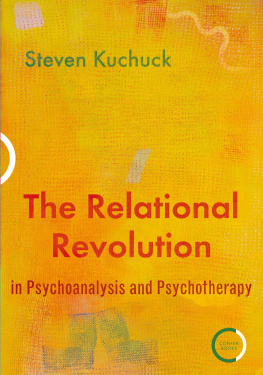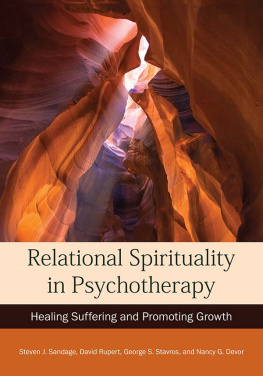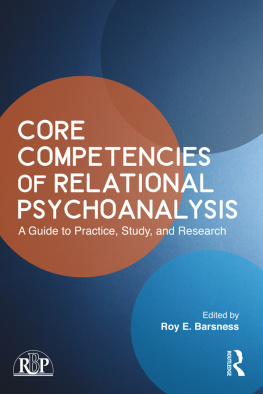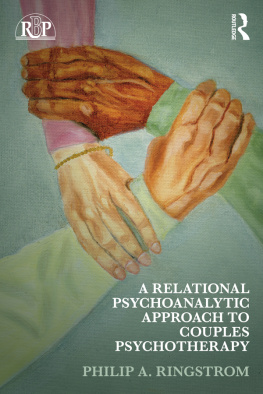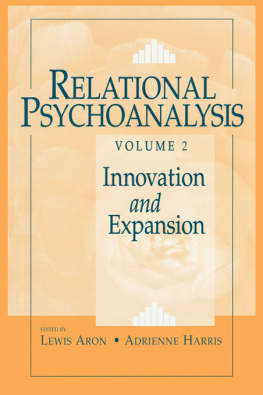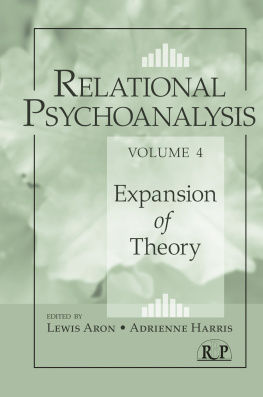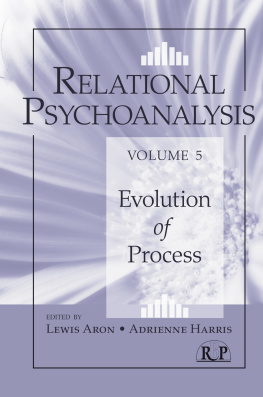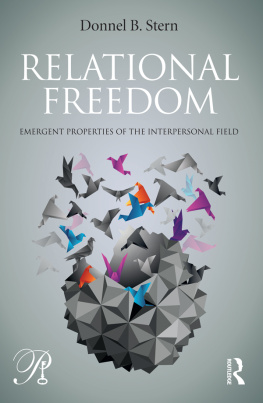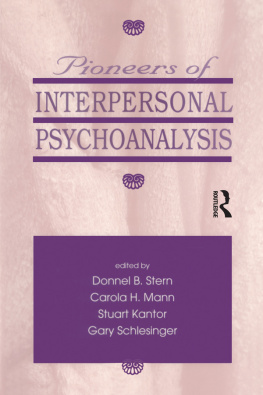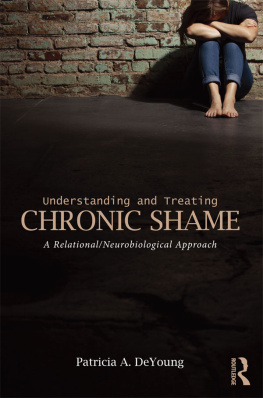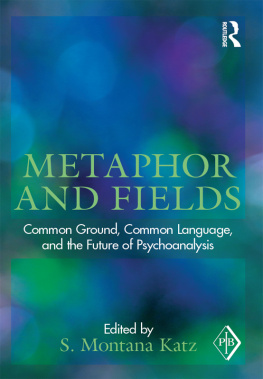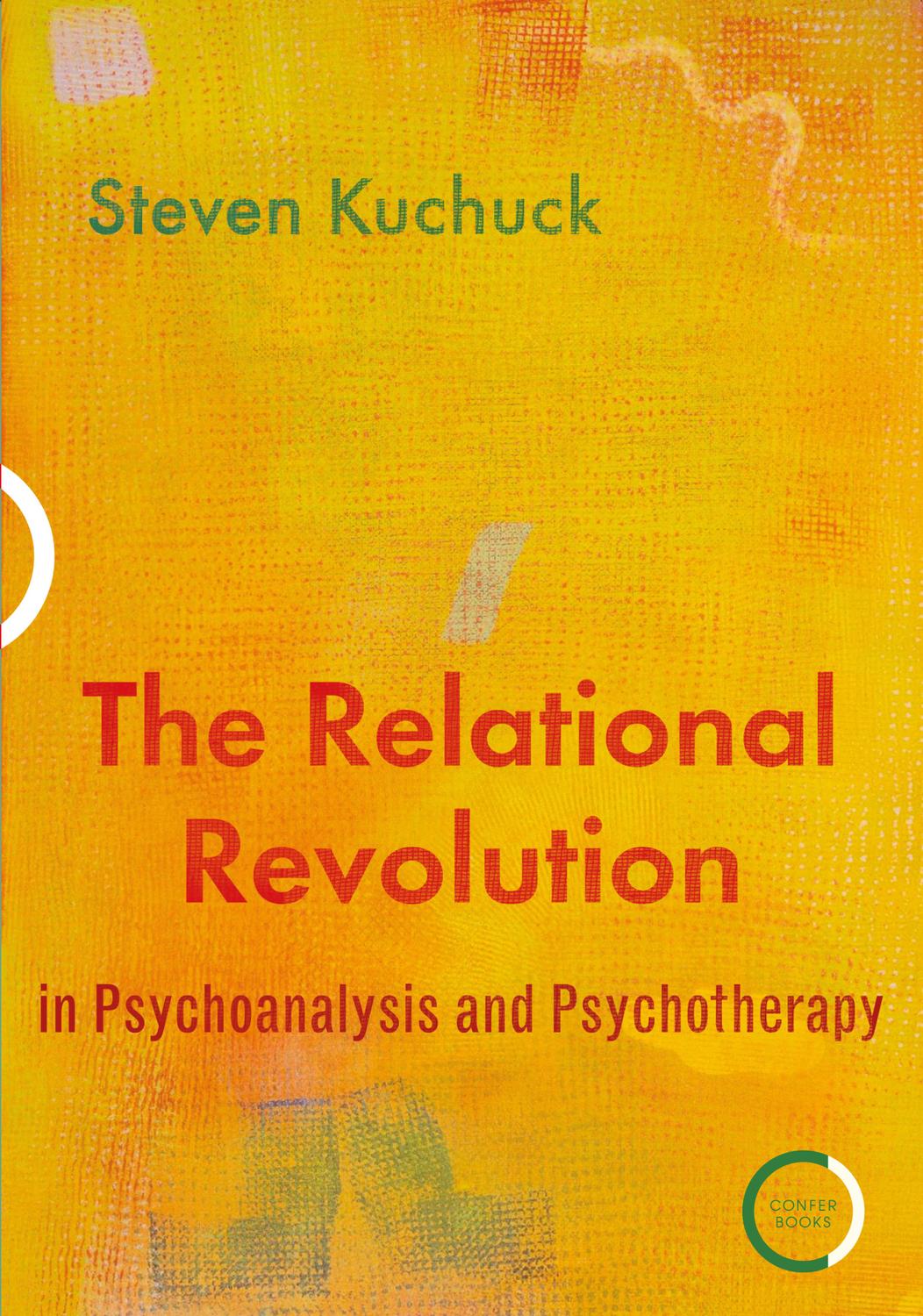I miss my friend Lew, the finest teacher and most passionate colleague and relational psychoanalytic torch bearer Ive ever known. Our field and hearts are emptier now, but also always full for having known him. I dedicate this book to Lew.
For David Flohr, who nurtures and sustains me and makes my life better in countless ways. Thank-you doesnt even come close.
And for my dear friends and colleagues Galit Atlas and Sharyn Leff, who were my readers, supporters and loving critics. Each in your way is a brilliant analyst and thinker and helped to make this a much better book than it otherwise would have been. Each of you helps to generously support me in so many personal and professional ways. Im not sure I could have, and certainly know that I would not have wanted to have writen this without you both by my side.
Sally Bjorklund has been a close friend and colleague for many years, and her theoretical savvy and insight make her one of the sharpest psychoanalytic thinkers and readers Ive ever known. Her generous contributions to this volume are significant. My loving friend and trusted confidant Hillary Grill has been an important part of my life and work since graduate school. She is always in my heart and very much viii a part of my thinking and development as an analyst, and therefore a part of these pages as well. Thank you to my good friends and colleagues Caryn Sherman Meyer and Ellen Fries.
I am forever grateful to my intellectually inspiring and nurturing professional home at the National Institute for the Psychotherapies and every one of my fellow Board members for your friendship, comradery, support and inspiration. Thank you especially Rachel Sopher, Amy Schwartz-Cooney, Ken Frank and Marc Sholes. Many of the ideas contained in these pages germinated there, and in my other psychoanalytic communities. So, thank you, too, to friends and colleagues at New York University Postdoctoral Program in Psychotherapy and Psychoanalysis, my talented co-editors in the Relational Perspectives Book Series, Adrienne Harris and Eyal Rozmarin, and my friends on the Executive Committee and Board of the Stephen Mitchell Relational Study Center.
Jessica Benjamin and Hazel Ipp have been friends and also important resources for me in the writing of this book and beyond. Thanks, too, to to Andrew Samuels and Bob Miller, for excellent suggestions that helped to shape the books title. And I thank my fellow IARPP Board members for your esprit de corps and commitment to teaching, learning and disseminating relational psychoanalysis, especially my friends Tony Bass and Margaret Black, with whom I have the pleasure of working together in other capacities as well, ix and Peggy Crastnopol, Susie Nebbiosi and Chana Ullman. Thanks, too, to Anja Behm for her careful translations of some of Freuds unpublished letters of enormous help on a simultaneous project and Carol Tosone, Director of the DSW Program at New York University Silver School of Social Work.
Thank you as well to Lily Swistel and John Garrett Tanner for excellent editorial assistance, Rod Tweedy, formerly of Confer Books, and Brett Kahr, Editor in Chief of Confer books, for their invitation to write this book and generous support and guidance along the way. Director of Publishing, Christina Wipf Perry, and Publishing Manager, Liz Wilson have been wonderful to work with wise, endlessly patient, generous and supportive. Julie Bennett of Bespoke Publishing was also a pleasure to engage with. Appreciation to Ted Holland at Hirschl & Adler Modern and Howard Shapiro at Lawrence Fine Art for providing the rights and image for the cover art.
Finally, deep appreciation for and gratitude to my patients, supervisees and students. Its more than a privilege to know and work with each of you. x
Psychoanalysis is a vibrant clinical process that continues to reinvent itself, finding new meanings for its methodology, as the experience and concerns of its participants change and develop.
Stephen Mitchell (1995), Hope and Dread in Psychoanalysis. New York: Basic Books
From the 19701980s and the advent of feminism, queer studies and postmodern thought (subjective, fallible, relative experience rather than objectivist truth or abstract principles that are assumed to be definite and universal), many in the mental health community began to more actively join with earlier sceptics and outright critics to challenge classical psychoanalysiss hierarchical, authoritarian, North American, Caucasian-centric, heterosexist perspective on human development and functioning (Shapiro, 1996; Levine, 2003). For many years before then, psychoanalysis had been criticized for at best misunderstanding women or, at worst, outright misogyny (Mitchell, J., 2000). Homosexuality was considered a perversion and even diagnosable pathology, and of course it wasnt until very recent years that transgender people were recognized as potentially healthy individuals who could be treated psychoanalytically for anything other than their obvious pathology.
Even those with a more forgiving or positive attitude towards the profession were beginning to recognize the limitations of an interpretive-heavy objectivist perspective in which an all-powerful, all-knowing authority could know another mind better than the patient could. In the United States and elsewhere, against this revolutionary backdrop of the 1960s, personal empowerment and the recognition of the above-named marginalized groups, psychoanalysis became more and more criticized from without and even from within the profession. It is in this context and against the backdrop of increasingly popular non-psychoanalytic treatment methods such as cognitivebehavioural therapy with its promise of quick, evidence-based, manualized approaches and cure that Relational psychoanalysis was born.
It is perhaps beyond the scope of this book to conjecture why it is that, in many cases, non-psychoanalytic mental health practitioners and the lay public seem not to be particularly familiar with psychoanalytic approaches other than classical Freudian, Jungian and/or Lacanian perspectives. These are the only psychoanalytic theories that seem to be taught in university undergraduate and graduate psychology, English or philosophy departments. They are no longer the most commonly taught perspectives in postgraduate training programmes and institutes; however, where advanced, postgraduate study is required for those who are interested in pursuing training to become a psychoanalyst after receiving their graduate degree in psychology, social work, psychiatry and the like.
This book will attempt a somewhat rare feat. Primarily written for clinicians and theorists, both in and outside of psychoanalysis, it will also attempt to serve as an introduction to one of the most exciting and still relatively new perspectives in psychoanalysis even more than 30 years after its founding for an interested non-professional readership as well. And for those already familiar with Relational psychoanalysis, my hope is that it will serve as an elementary textbook of a sort, introducing or reviewing key concepts and providing carefully considered citations and references for those who want to examine original and supplemental sources. As of this writing, and at least as far as Im aware, this is one of the few introductory texts to Relational thinking since Greenberg and Mitchells pioneering work (1983, though this text was written to introduce what came to be known as small r relational psychoanalysis, which preceded most of the concepts that I outline here in the pages to follow) and subsequent volumes by Lewis Aron (1996), Paul Wachtel (2008), Skolnick and Warshaws edited volume (1992), Loewenthal and Samuels edited collection (2014), Cornell and Hargadens (2005) compendium of Relational writing within Transactional Analysis, and Barsnesss edited work (2017). It may be the first primer, however, and, in that respect, it is designed to provide an overview of both foundational as well as newer thinking developed by the early founders of this perspective and subsequent generations of Relational thinkers. All theoretical material is illustrated with clinical examples, and the volume concludes with thoughts about areas in need of further study and emphasis.

